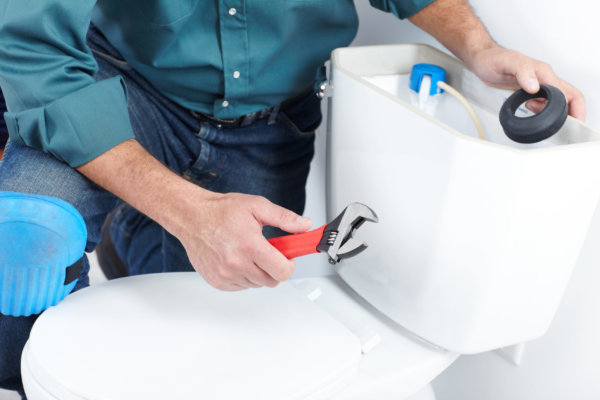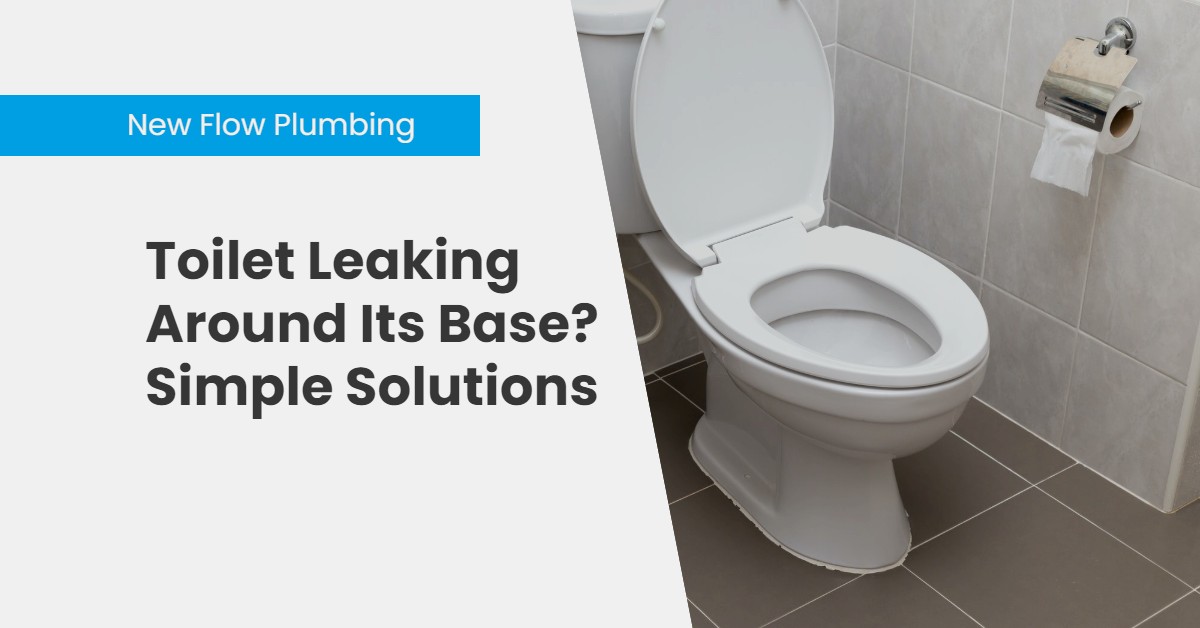Toilet Leaking at the Base? Causes, Fixes, and Prevention Tips
A toilet leaking at the base is one of the most common plumbing problems homeowners face. Not only is it messy and unpleasant, but it can also lead to water damage, mold growth, and higher utility bills if ignored. The good news is that this problem usually has a clear cause and a straightforward solution. Effective methods to stop a toilet from leaking around its base is replacing the wax ring seal, which often breaks down over time. By catching the issue early and understanding the different reasons it may happen, you can save yourself from bigger plumbing problems later. In this article, we’ll walk through the most common causes, proven fixes, and practical prevention tips so you can keep your bathroom safe, dry, and worry-free.
Why a Toilet Leaks at the Base
A toilet is designed to carry water and waste safely through a sealed system. When water appears around the bottom of the toilet, it means that the seal has failed somewhere. Unlike drips from the tank or supply line, leaks at the base are usually tied to problems where the toilet connects to the floor drain. Because gravity naturally pulls water downward, the base is often the first place you’ll see evidence of a problem.
A toilet leaking at the base is not just a small nuisance. Even a slow leak can soak into flooring, damage subflooring, and create musty odors. Understanding why it happens is the first step to fixing it effectively.
How to Spot the Signs Early
Sometimes a base leak is obvious because water pools around the toilet after every flush. Other times, the signs are more subtle. Look for:
- Water stains on the floor around the toilet.
- Soft or spongy flooring near the base.
- Persistent musty or mildew smells.
- A toilet that shifts or rocks when you sit on it.
By paying attention to these early warning signs, you can act quickly before the problem grows into something that requires major repairs.

Common Causes of Toilet Leaks
There are several reasons you might notice water around your toilet. Some of the most common include:
- Worn wax ring: The wax ring between the toilet and the flange keeps the connection watertight. Over time, it can crack, dry out, or shift out of place.
- Loose closet bolts: These bolts secure the toilet to the flange. If they’re not tight enough, water may escape.
- Cracks in the porcelain: Hairline cracks in the toilet bowl or base can allow water to leak.
- Condensation: In humid climates, condensation may drip down and pool around the toilet, sometimes mistaken for a leak.
- Damaged flange: If the flange is broken or corroded, the toilet may not sit properly, leaving gaps for water to escape.
Each of these issues requires a slightly different fix, which we’ll cover step by step.
The Role of the Wax Ring Seal
The wax ring plays a critical role in keeping a toilet sealed to the drain. It compresses when the toilet is set onto the flange, creating a watertight barrier that prevents leaks and sewer gas from escaping. When a toilet leaks at the base, a failed wax ring is often the culprit.
The good news is that replacing a wax ring is affordable and, with some patience, a task many homeowners can handle themselves. This is why we consider wax ring replacement one of the most reliable solutions for fixing leaks at the toilet base.
Step-by-Step Fixes for Toilet Leaking at the Base
Step 1: Shut Off the Water Supply
Turn the shut-off valve near the toilet clockwise until it stops. Flush the toilet to remove most of the water from the tank and bowl.
Step 2: Remove Remaining Water
Use a sponge, small cup, or wet/dry vacuum to clear out any leftover water. This makes lifting the toilet easier and less messy.
Step 3: Disconnect the Water Line
Loosen the nut that connects the supply line to the tank. Place a towel underneath to catch any drips.
Step 4: Remove the Toilet
Unscrew the closet bolts holding the toilet to the floor. Rock the toilet gently to break the seal, then lift it carefully.
Step 5: Inspect and Replace the Wax Ring
Scrape off the old wax ring using a putty knife. Place the new ring evenly around the flange, making sure it’s centered.
Step 6: Reinstall the Toilet
Lower the toilet straight down onto the flange. Press firmly to compress the wax. Tighten the bolts evenly without overtightening, which can crack the porcelain.
Step 7: Reconnect and Test
Reconnect the water line, turn the valve back on, and flush several times. Watch closely to see if any water seeps out at the base.
Tools and Materials You’ll Need
- Adjustable wrench
- Putty knife
- Replacement wax ring (standard or reinforced)
- Sponge or wet/dry vacuum
- Towels
- Screwdriver
- New closet bolts (optional if old ones are corroded)
Having the right tools on hand makes the repair smoother and faster.
When Tightening Bolts Can Help
Sometimes a toilet leaks simply because the bolts holding it to the flange have loosened over time. In this case, gently tightening the bolts may solve the problem. Be careful not to crank them down too hard, as this can crack the porcelain base. If tightening doesn’t work, replacing the wax ring is usually the next step.
When to Replace the Wax Ring
If water still appears after tightening the bolts or if the wax ring is visibly damaged, replacement is the best fix. Wax rings are inexpensive and can last for years when installed properly.
Dealing with Cracked Porcelain or Tank Issues
If you find cracks in the toilet bowl or tank, the only permanent fix is usually replacement. Small hairline cracks above the waterline may be sealed temporarily, but anything below the waterline will likely continue leaking.
Preventive Maintenance to Stop Future Leaks
Preventing a toilet from leaking at the base is easier than dealing with a full repair later. Some preventive steps include:
- Checking for movement by gently rocking the toilet a few times a year.
- Inspect the floor around the toilet for soft spots.
- Avoid harsh cleaners that may degrade seals.
- Replace the wax ring every time the toilet is removed for any reason.
Regular maintenance not only prevents leaks but also extends the life of your bathroom flooring.
Health and Safety Concerns of Ignoring a Leak
Standing water around a toilet base can cause more than cosmetic issues. It creates a breeding ground for mold and bacteria. Over time, water can damage flooring and subflooring, leading to expensive repairs. In severe cases, leaks can also release sewer gases into the home, which is both unpleasant and unhealthy.
When It’s Time to Call a Professional
While many leaks can be handled with basic tools and patience, there are times when professional help is the safest choice. Consider calling a plumber if:
- The toilet rocks heavily and won’t stabilize.
- The flange is damaged or corroded.
- Cracks are found in the porcelain.
- Multiple attempts to fix the leak have failed.
A professional can assess the situation and make sure the repair lasts.
Cost Considerations and What to Expect
Fixing a toilet leaking at the base is often affordable compared to other plumbing issues. A wax ring costs just a few dollars, and even professional installation is usually much less expensive than repairing water-damaged flooring. The sooner you address the problem, the less you’ll spend overall.
Final Thoughts
A toilet leaking at the base is not a problem you want to ignore. While it may seem minor, it can quickly lead to larger issues like water damage, foul odors, and higher repair bills. The most common solution is replacing the wax ring, but tightening bolts or addressing cracks may also be necessary. By learning how to spot the signs early, understanding the causes, and following preventive steps, you can protect your home and keep your bathroom in top shape.
FAQs

Arman Grigoryan
Founder & President of New Flow Plumbing
Arman Grigoryan is the founder and president of New Flow Plumbing, proudly serving Los Angeles, Sacramento, and surrounding areas. With extensive experience in plumbing diagnostics, he leads a skilled team specializing in advanced sewer and drain camera inspections to quickly identify problems and deliver lasting solutions. Arman is dedicated to using the latest technology to provide reliable service, honest answers, and dependable results for every customer.







